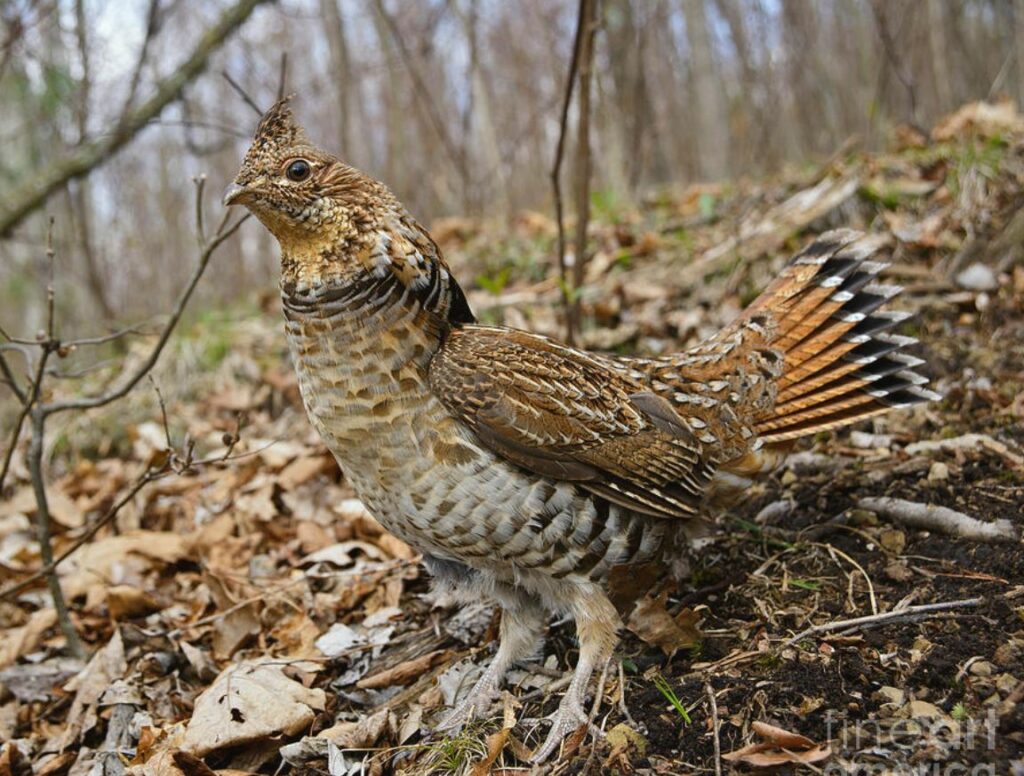Pennsylvania’s state bird, the ruffed grouse, and a wide range of other Species of Greatest Conservation Need will benefit from the partnership


December 14, 2021 (Coraopolis, PA) – The Ruffed Grouse Society & American Woodcock Society (RGS & AWS), American Bird Conservancy (ABC), Indiana University of Pennsylvania (IUP), and Audubon Mid-Atlantic (AMA) are excited to partner with Domtar to improve habitats through active forest management and pulpwood sourcing. The project will improve habitat for game and non-game wildlife, using an innovative approach that creates landowner income and jobs in rural Pennsylvania.
A lack of critical habitat for birds and other wildlife has led to population declines of ruffed grouse, Pennsylvania’s state bird, and other imperiled forest birds, such as the golden-winged warbler and the wood thrush. Specifically, a preponderance of closed-canopy, single-aged forests has resulted in too little young forest and a plethora of older forest with limited vertical structure (understory) that is essential for nesting and foraging. The new partnership will address these issues through promoting sustainable, science-based timber harvesting that diversifies forest age classes, structure, and tree species composition at landscape scales. In some cases, the work will involve restoring forest health to stands with a history of poor management, which involved removing only the most valuable sawtimber trees, leaving degraded stands with limited economic and wildlife value.
“As conservationists, we need to act quickly to reverse the decades-long decline in ruffed grouse, American woodcock, and other forest bird populations. New opportunities like this help us fast forward our conservation progress,” said Ben Jones, President & CEO of RGS & AWS. “The beauty of working with Domtar is that they create value out of the low-grade trees we would otherwise have to pay to remove. We deeply appreciate Domtar’s support for our partnership, which will efficiently create critical habitat at scale.”
“Domtar is happy to be able to support this innovative partnership to help restore balance to the landscape,” said Luke Dillinger, Domtar’s Wood Procurement Manager in Johnsonburg, PA. “The committed organizations involved bring the experience, dedication, and know-how needed to be effective at the landscape level.”
“The golden-winged warbler has suffered one of the steepest population declines of any songbird in the region primarily due to loss of the early-successional forest habitat it requires for successful breeding. With support from Domtar, partners will be able to create high quality young forest habitat within a mosaic of forest cover types and ages across the landscape,” said Shawn Graff, Vice President of the American Bird Conservancy. “This project will benefit not only golden-winged warblers but a suite of species that have a diverse array of life cycle requirements.”
“During the past 50 years, the United States has lost more than 170 million eastern forest birds. Recovering these species means diversifying the age, structural conditions, and tree species composition of our forests,” said Ron Rohrbaugh, Director of Conservation Science at Audubon Mid-Atlantic. “We are excited and grateful to partner with Domtar. This important project is a win-win, as it scales science-based management to make biologically meaningful change for birds and other wildlife, while also providing Domtar with valuable access to pulpwood supplies that will keep local businesses and communities thriving.”
Domtar provides a stable, robust market for low-grade wood (pulpwood). Harvesting of this low-grade material is a critical component in implementing good forest management that increases long-term value to landowners and benefits wildlife. Without markets for pulpwood and other types of wood, private forest owners and public land managers would have to pay for all forest management, which would greatly decrease the number of acres of habitat that can be improved.
The project builds on ongoing collaboration between RGS & AWS, ABC, IUP, and AMA to improve forest habitats on private and public lands, particularly PA State Game Lands. The partnership with Domtar will allow partners to reach out to other landowners, especially family forest owners, to help them implement forest management that benefits wildlife.
This new project combines the partners’ unique strengths:
• RGS & AWS will coordinate project and lead the landowner outreach
• ABC & IUP will lead the monitoring of forest birds
• AMA will train forest owners and foresters on forest management can provide critical forest habitat
• Domtar will support the partnership and have the option to purchase pulpwood from the habitat-oriented forest management projects
Partners are collaborating with local consulting foresters who will write forest management plans (as needed) and assist landowners in implementing them. The partners look forward to working with Domtar, consulting foresters, landowners, and nearby communities to improve habitats while helping to creating valuable products, landowner income, and supporting jobs from low-grade forest products.

